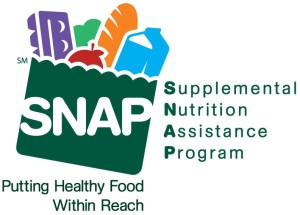>> BY JESSICA WILKERSON, PhD Candidate in History, UNC-Chapel Hill I recently had a conversation with a family member—let’s call her Sally—who is convinced that our cousin, who is poor and struggles with drug addiction, got pregnant so that she could receive more Supplemental Nutrition Assistance Program (SNAP) benefits, or food stamps. “You think she sees a baby as her ticket to more food?” I asked, perplexed. “Well, she probably sells her food stamps for drugs,” Sally explained. I responded that I’m pretty sure that would be very difficult, if not impossible, but it’s no use: Sally is convinced that our cousin—who has been so crippled by drug addiction that she cannot work and has lost custody of her children—is manipulating the system. Without any evidence that this is the case (reports show that “trafficking” food stamps is extremely rare), this is Sally’s ready anecdote that food stamps are ineffective.
BY JESSICA WILKERSON, PhD Candidate in History, UNC-Chapel Hill I recently had a conversation with a family member—let’s call her Sally—who is convinced that our cousin, who is poor and struggles with drug addiction, got pregnant so that she could receive more Supplemental Nutrition Assistance Program (SNAP) benefits, or food stamps. “You think she sees a baby as her ticket to more food?” I asked, perplexed. “Well, she probably sells her food stamps for drugs,” Sally explained. I responded that I’m pretty sure that would be very difficult, if not impossible, but it’s no use: Sally is convinced that our cousin—who has been so crippled by drug addiction that she cannot work and has lost custody of her children—is manipulating the system. Without any evidence that this is the case (reports show that “trafficking” food stamps is extremely rare), this is Sally’s ready anecdote that food stamps are ineffective.
Sally is not alone, and she is not unreasonable for thinking that the program is flawed. The public debate on the food stamp program often focuses on problems, from stories of widespread abuse, to >>reports linking food stamps to obesity and diabetes, to warnings that the program is a fundamental cause of the nation’s debt. Such reports have only multiplied as debates on the Farm Bill—legislation that funds agriculture and nutrition programs—reignited in Congress with the last extension set to expire in January. The message thus far has been that cuts are in order (beyond the $5 billion that went into effect on November 1). The Senate has proposed $4.5 billion in additional cuts in the coming decade while the House proposed $40 billion.
The history of food stamps is too often missing in these debates. In the early 1960s a series of studies showed that hunger and malnutrition were pervasive in poor regions of the country. Doctors reported high rates of anemia in infants, stunted growth and low hemoglobin levels in children, and pregnant women suffering from nutritional deficiencies. Prompted by these findings, national public figures addressed the question: What can we do about hunger and malnutrition in our nation? That question motivated President Lyndon B. Johnson and his administration to oversee the Food Stamp Act of 1964, legislation that built on food assistance programs established during the Great Depression. In his statement upon signing the legislation, Johnson declared that in a nation like ours, with abundant food, no child should go hungry. With the right amount of cooperation between state and federal governments, hunger was a problem that could be solved.
The effects of the Food Stamp Act were not immediate. As we continue to consider the role of food assistance in our society, we should remember the many poor and working mothers who fought for better access to food stamps in the 1960s. In the years just after the Food Stamp Act passed, there were many problems with the program. Families had to purchase food stamps, making them unavailable for the most cash-poor households. Moreover, not all counties offered the program, so many people did without.
In 1968 Senator Robert F. Kennedy joined civil rights and labor groups to investigate poverty-related hunger across the nation. At the public hearings, mothers from Texas, Kentucky, Georgia, and South Carolina testified about their hardships and why they needed food assistance. Many of them outlined in painstaking detail how they spent every penny—on food, medicine, bills, school expenses—and how they often ran out of money and food by the end of the month. Those who received food stamps noted that without them, their lives would have been even more difficult. Food insecurity was often a starting point for women to discuss the many facets of poverty. Their testimonies underscored the lack of well-paying jobs for women, how they often made tough choices about how to spend money as they juggled food and medical expenses, and how they faced financial collapse when a husband died or left a family.
Other women campaigned at their state capitals and county courthouses, demanding that food stamp offices open in their communities. For rural women especially, with no public transportation, poor roads, and miles between them and food stamp offices, traveling to offices was a hardship, one more in a litany of burdens.
Women’s persistent efforts to make the system more responsive to those most in need led up to the 1977 Food Stamp Act, a bipartisan bill which made food stamps more accessible to poor families. Women also played a role in the establishment of the program Women, Infants, and Children (WIC) which assists low-income mothers with children up to age five.
The women who testified to make the food assistance programs work better were not attempting to cheat the system. As one woman testified at a hearing in Kentucky, “Of course I want to pay if I can and I feel that anybody that can pay it should pay it, but right now we just can’t.” It was probably not easy for women to stand before public officials and tick off their household expenses, share their personal hardships, or admit that they could not always feed their children. But they did so because then, just as now, there were pervasive myths that people on welfare and food stamps were lazy, dependent on government, and undeserving of public assistance, even as their experiences as well as the data revealed a complex portrait of poverty.
Because of those women and the public officials who listened to them, food stamps have become one of the most successful social programs in our country. While the SNAP program can be improved, its limitations do not take away from the fact that severe malnutrition, a surprisingly prevalent problem in the 1960s, has been nearly wiped out, according to the >>Center on Budget and Policy Priorities.
Despite the program’s successes in preventing severe food insecurity, once again we are coming to a moment when years of hard work is being called into question and >>SNAP recipients are facing severe cuts to public assistance. Myths about the food stamp program distract us from that success story. They render invisible the history of how poor and working mothers helped to usher in a program that has shielded thousands from hunger, malnutrition, and the harshest effects of poverty.
Jessie Wilkerson is a Ph.D. Candidate in Women’s and Gender History at UNC Chapel Hill, and she is currently an AAUW American Fellow. Her dissertation, “Where Movements Meet: Women’s Activism in the Appalachian South, 1965–1980,” traces the alliances forged and the movements led by women in the Appalachian South in the late 1960s and 1970s.

There are no comments
Add yours